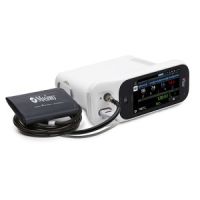Masimo has announced the findings of a recent study conducted on children admitted to a Ugandan hospital with fever and malaria, in which Masimo’s noninvasive measurement SpMet® was used to monitor methemoglobin (MetHb) levels. One group of children with severe malaria was selected to receive inhaled nitric oxide (iNO) treatment as an adjunct to intravenous therapy while a placebo group received room air. Both of these groups were monitored with SpMet.1
Red blood cells containing hemoglobin can become oxidized in the presence of certain drugs and compounds, including nitric oxide, changing it to methemoglobin (MetHb), which impairs the oxygen-carrying capacity of blood. When MetHb levels rise, headache, respiratory distress, cyanosis, and finally death may occur. A 2004 study conducted at Johns Hopkins Hospital reported that 20% of the patients tested, from neonates to geriatrics, had elevated MetHB caused by the side effects of 40 drugs given to patients in hospitals, including nitric oxide. Three patients nearly died and one patient died from elevated MetHb during the study period.2
An estimated 1.2 million people die from malaria annually worldwide, with a mortality rate of 8-20% in children with severe malaria.3 In the Ugandan study, Dr. Andrea Conroy and colleagues at Jinja Regional Referral Hospital assessed an adjunctive therapy for malarial patients: the administration of inhaled nitric oxide (iNO) – but as iNO is absorbed by the body, it “induces MetHb in a dose-dependent manner.” Noting that “[t]here are no reliable estimates of methemoglobinemia in low resource clinical settings,” but seeking to “evaluate whether iNO could improve clinical recovery…in a cohort of children with severe malaria,” the investigators chose to monitor MetHb levels during treatment with a Masimo Rad-57® Pulse CO-Oximeter®with noninvasive SpMet monitoring.
The investigators in Uganda selected 180 children admitted to the hospital with severe malaria between 2011 and 2013 to receive either iNO (n=88) or a placebo, room air (n=92), in conjunction with standard anti-malarial treatment. MetHb levels were measured on a four-hourly basis following gas initiation, using Masimo SpMet. Between gas initiation and the first check with SpMet, MetHb levels rose from an average of 1.8% to 4.1% for the iNO group but stayed the same (1.7% to 1.8%) in the placebo group. MetHb levels typically plateaued within 12-24 hours of receiving iNO. Gas was withdrawn for 31 children (placebo: 12; iNO: 19; p=0.13).
The researchers stated that “we were able to evaluate the variability in MetHb responses within subjects and the frequency of methemoglobinemia prompting study gas discontinuation. Despite the high doses of iNO administered, study gas was temporarily discontinued only five times for MetHb >10% (all children in the iNO group). We were able to re-start study gas for all children that had a MHb measurement that exceeded 10% once the MetHb returned to <7 % without having the MetHb exceed 10% again. It was not necessary to wean children off iNO, in contrast to studies administering iNO to neonates with hypoxic respiratory failure, as we did not observe any rebound effects (e.g. worsening oxygenation) following discontinuation of study gas.”
The authors concluded that, “Hospitalized children with evidence of impaired oxygen delivery, metabolic acidosis, anemia, or malaria were at risk of methemoglobinemia. However, we demonstrated high-dose iNO could be safely administered to critically ill children with severe malaria with appropriate MHb monitoring.”
Joe Kiani, Founder and CEO of Masimo, stated, “It’s great to see that our invention of continuous methemoglobin monitoring has allowed these clinicians to study the outcomes of administering iNO treatment. We hope to continue developing monitoring technologies that help to address such public health crises.”
SpMet monitoring is not intended to be used as the sole basis for making diagnosis or treatment decisions. It is intended to be used in conjunction with other clinical tools, including signs and symptoms and laboratory blood tests.
References
- Conroy et al. Methemoglobin and nitric oxide therapy in Ugandan children hospitalized for febrile illness: results from a prospective cohort study and randomized double-blind placebo-controlled trial. BMC Pediatrics. (2016) 16:177. DOI 10.1186/s12887-016-0719-2.
- Ash-Bernal et al. Acquired methemoglobinemia: A retrospective series of 138 cases at 2 teaching hospitals. Medicine. October 2004;83(5)265-73. DOI 10.1097/01.md.000141096.00377.3f.
- Murray et al. Global malaria mortality between 1980 and 2010: a systematic analysis. Lancet. 2012;379(9814):413-31.



























